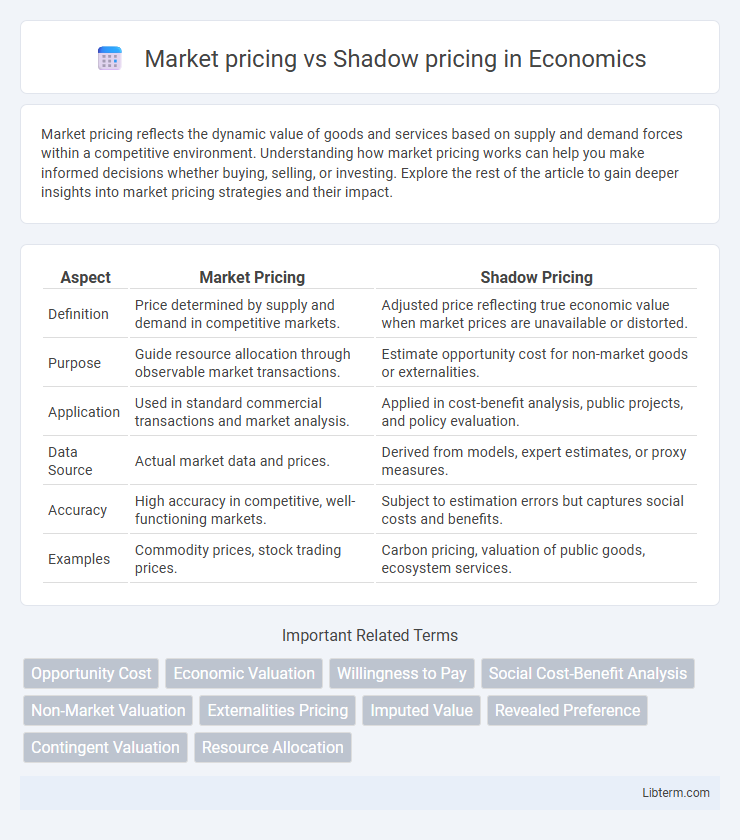Market pricing reflects the dynamic value of goods and services based on supply and demand forces within a competitive environment. Understanding how market pricing works can help you make informed decisions whether buying, selling, or investing. Explore the rest of the article to gain deeper insights into market pricing strategies and their impact.
Table of Comparison
| Aspect | Market Pricing | Shadow Pricing |
|---|---|---|
| Definition | Price determined by supply and demand in competitive markets. | Adjusted price reflecting true economic value when market prices are unavailable or distorted. |
| Purpose | Guide resource allocation through observable market transactions. | Estimate opportunity cost for non-market goods or externalities. |
| Application | Used in standard commercial transactions and market analysis. | Applied in cost-benefit analysis, public projects, and policy evaluation. |
| Data Source | Actual market data and prices. | Derived from models, expert estimates, or proxy measures. |
| Accuracy | High accuracy in competitive, well-functioning markets. | Subject to estimation errors but captures social costs and benefits. |
| Examples | Commodity prices, stock trading prices. | Carbon pricing, valuation of public goods, ecosystem services. |
Understanding Market Pricing: Definition and Key Concepts
Market pricing refers to the determination of asset or product prices based on supply and demand dynamics within competitive marketplaces, reflecting real-time transaction values. It incorporates factors such as production costs, consumer preferences, competition intensity, and external economic influences, providing transparent signals for resource allocation. Understanding market pricing is essential for investors and businesses to evaluate fair value, optimize strategies, and respond effectively to market fluctuations.
What is Shadow Pricing? Exploring the Basics
Shadow pricing refers to the assignment of a monetary value to goods, services, or resources not typically traded in markets, such as environmental benefits or social costs, to better reflect their true economic worth. It is used in cost-benefit analysis and project evaluation to capture externalities and guide decision-making when market prices are unavailable or distorted. Shadow pricing helps organizations and policymakers estimate opportunity costs and allocate resources more efficiently beyond conventional market valuation.
Core Differences Between Market and Shadow Pricing
Market pricing reflects actual prices determined by supply and demand in competitive markets, serving as observable signals for resource allocation. Shadow pricing, in contrast, estimates the implicit value of goods or services not traded in markets, often applied in project evaluation or policy analysis to capture social costs or benefits. Core differences include market pricing's basis on existing transactions versus shadow pricing's use of hypothetical or adjusted values to incorporate externalities and non-market factors.
Factors Influencing Market Pricing Mechanisms
Market pricing mechanisms are primarily influenced by supply and demand dynamics, production costs, competition intensity, and government regulations, reflecting real-time economic conditions. Shadow pricing, however, considers opportunity costs and externalities not captured in market prices, such as environmental impact and social costs. Factors like market imperfections, monopoly power, and information asymmetry also significantly affect the accuracy of market pricing mechanisms.
The Methodology Behind Calculating Shadow Prices
Shadow pricing methodology involves estimating the true economic value of goods or services by incorporating externalities, market distortions, and non-monetary factors often ignored in market pricing. It uses techniques such as cost-benefit analysis, opportunity cost evaluation, and willingness-to-pay assessments to reflect the social cost or benefit of resources. This approach enables more accurate decision-making in public projects and environmental economics where market prices fail to capture full economic impacts.
Real-World Applications of Market Pricing
Market pricing reflects actual transaction prices driven by supply and demand in competitive markets, making it essential for asset valuation, financial markets, and trading decisions. It provides transparent, real-time information that companies and investors use to allocate resources efficiently and assess risk accurately. Shadow pricing is often applied in policy analysis or projects where market prices are absent or distorted, but market pricing remains the primary benchmark in real-world financial and economic applications.
Shadow Pricing in Public Policy and Non-Market Valuation
Shadow pricing plays a crucial role in public policy by assigning monetary values to goods and services not traded in traditional markets, such as environmental benefits or social impacts. This technique enables policymakers to evaluate the true costs and benefits of projects by incorporating externalities and non-market factors, ensuring more efficient resource allocation. Unlike market pricing, which reflects observable transaction prices, shadow pricing relies on estimation methods like contingent valuation or revealed preferences to capture societal values absent from market data.
Advantages and Limitations of Market Pricing
Market pricing offers the advantage of reflecting real-time supply and demand dynamics, providing transparent and widely recognized price signals for goods and services. However, it can be limited by market imperfections such as externalities, information asymmetry, and monopolistic practices, which may lead to inefficient resource allocation. Market prices often fail to capture social costs or benefits, making them inadequate for evaluating public goods or environmental impacts.
When and Why to Use Shadow Pricing Over Market Pricing
Shadow pricing is used instead of market pricing when market prices fail to reflect the true social or economic value of goods or services, especially in cases involving externalities, public goods, or government interventions. It is particularly essential in cost-benefit analysis for public projects, environmental assessments, or policies where market distortions exist or market prices are absent. Shadow pricing captures the opportunity cost and societal impacts more accurately, guiding better decision-making in resource allocation and policy evaluation.
Impact of Pricing Methods on Decision-Making and Resource Allocation
Market pricing reflects actual supply and demand dynamics, providing real-time signals that guide efficient resource allocation in competitive markets. Shadow pricing estimates the true economic value of resources or goods not traded in markets, enabling more informed decision-making in public projects or environmental assessments where market prices are absent or distorted. The choice between market and shadow pricing significantly influences investment decisions, prioritization of resources, and policy formulation, impacting overall economic efficiency and social welfare outcomes.
Market pricing Infographic

 libterm.com
libterm.com